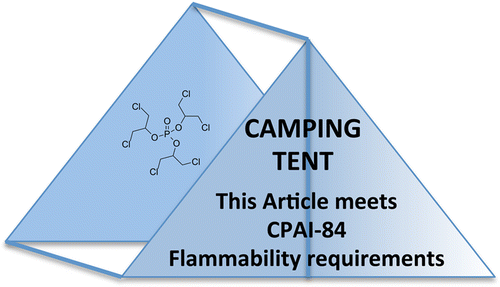Tent camping could lead to flame retardant exposure

For campers, nothing beats sleeping in a tent in the great outdoors. But scientists are finding out the air inside tents might not be as fresh as people think. A study appearing in Environmental Science & Technology has found that flame retardants used in the manufacturing of tents are released in the air within this enclosed space, which could lead to campers breathing them in.
Millions of Americans go camping every year to escape urban and suburban crowds and to reconnect with nature. They might not be aware, however, that many tents sold in the United States are treated with flame retardants. This helps prevent them from igniting if errant campfire flames get too close. Studies have shown that some of these compounds are associated with reproductive and developmental problems. Other reports on exposure and health impacts of the compounds have focused largely on exposure to them by touching electronics and furniture. Heather M. Stapleton and colleagues wanted to see whether camping tents might be a source of exposure, too.
The researchers tested the air space inside 15 different tents for a set of known flame retardants. The air samples contained varying levels of these compounds, depending on the brand of tent. Based on their measurements, the researchers estimated that campers sleeping for eight hours inside the tents could potentially inhale compound levels ranging from a few nanograms per kilogram of bodyweight to 400 nanograms per kilogram of bodyweight. This is less than the acceptable daily dose of 5 micrograms per kilogram of bodyweight—as set by the U.S. Consumer Product Safety Commission—of the most common flame retardant identified in the study. However, researchers say that recognizing all sources of exposure is important for ultimately determining any potential health effects. Because of their low body weight, children would likely experience relatively higher levels than adults, they say. The researchers also checked the hands of 20 volunteers before and after setting up tents. The levels of organophosphate flame retardants on the skin were significantly higher after set-up than before.
More information: Genna Gomes et al. Characterizing Flame Retardant Applications and Potential Human Exposure in Backpacking Tents, Environmental Science & Technology (2016). DOI: 10.1021/acs.est.6b00923
Abstract
Flame retardant (FR) chemicals are applied to products to meet flammability standards; however, exposure to some additive FRs has been shown to be associated with adverse health effects. Previous research on FR exposure has primarily focused on chemicals applied to furniture and electronics; however, camping tents sold in the United States, which often meet flammability standard CPAI-84, remain largely unstudied in regards to their chemical treatments. In this study, FRs from five brands of CPAI-84-compliant, two-person backpacking tents were measured and potential exposure was assessed. Dermal and inhalation exposure levels were assessed by collecting hand wipes from 20 volunteers before and after tent setup and by using active air samplers placed inside assembled tents, respectively. Organophosphate flame retardants (OPFRs) were the most commonly detected FR in the tent materials and included triphenyl phosphate (TPHP), tris(1,3-dichloro-2-propyl)phosphate (TDCIPP) and tris(2-chloroethyl)phosphate (TCEP). Levels of OPFRS measured on hand wipes were significantly higher post-tent setup compared to pre setup, and in the case of TDCIPP, levels were 29 times higher post setup. OPFRs were also detected at measurable concentrations in the air inside of treated tents. Significant, positive correlations were found between FR levels in treated textiles and measures of dermal and inhalation exposure. These results demonstrate that dermal exposure to FRs occurs from handling camping tents and that inhalation exposure will likely occur while inside a tent.
Journal information: Environmental Science & Technology
Provided by American Chemical Society


















